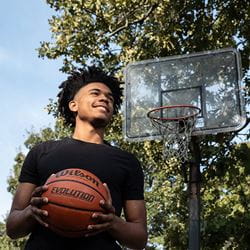GIVE NOW before 2025 ends—your gift will be doubled to help children in need. Click here to 2x your impact!

Ranked nationally in pediatric care.
Arkansas Children's provides right-sized care for your child. U.S. News & World Report has ranked Arkansas Children's in seven specialties for 2025-2026.

It's easier than ever to sign up for MyChart.
Sign up online to quickly and easily manage your child's medical information and connect with us whenever you need.

We're focused on improving child health through exceptional patient care, groundbreaking research, continuing education, and outreach and prevention.

When it comes to your child, every emergency is a big deal.
Our ERs are staffed 24/7 with doctors, nurses and staff who know kids best – all trained to deliver right-sized care for your child in a safe environment.

Arkansas Children's provides right-sized care for your child. U.S. News & World Report has ranked Arkansas Children's in seven specialties for 2025-2026.

Looking for resources for your family?
Find health tips, patient stories, and news you can use to champion children.

Support from the comfort of your home.
Our flu resources and education information help parents and families provide effective care at home.

Children are at the center of everything we do.
We are dedicated to caring for children, allowing us to uniquely shape the landscape of pediatric care in Arkansas.

Transforming discovery to care.
Our researchers are driven by their limitless curiosity to discover new and better ways to make these children better today and healthier tomorrow.

We're focused on improving child health through exceptional patient care, groundbreaking research, continuing education, and outreach and prevention.

Then we're looking for you! Work at a place where you can change lives...including your own.

When you give to Arkansas Children's, you help deliver on our promise of a better today and a healthier tomorrow for the children of Arkansas and beyond

Become a volunteer at Arkansas Children's.
The gift of time is one of the most precious gifts you can give. You can make a difference in the life of a sick child.

Join our Grassroots Organization
Support and participate in this advocacy effort on behalf of Arkansas’ youth and our organization.

Learn How We Transform Discovery to Care
Scientific discoveries lead us to new and better ways to care for children.

Learn How We Transform Discovery to Care
Scientific discoveries lead us to new and better ways to care for children.

Learn How We Transform Discovery to Care
Scientific discoveries lead us to new and better ways to care for children.

Learn How We Transform Discovery to Care
Scientific discoveries lead us to new and better ways to care for children.

Learn How We Transform Discovery to Care
Scientific discoveries lead us to new and better ways to care for children.

Learn How We Transform Discovery to Care
Scientific discoveries lead us to new and better ways to care for children.

When you give to Arkansas Children’s, you help deliver on our promise of a better today and a healthier tomorrow for the children of Arkansas and beyond.

Your volunteer efforts are very important to Arkansas Children's. Consider additional ways to help our patients and families.

Join one of our volunteer groups.
There are many ways to get involved to champion children statewide.

Make a positive impact on children through philanthropy.
The generosity of our supporters allows Arkansas Children's to deliver on our promise of making children better today and a healthier tomorrow.

Read and watch heart-warming, inspirational stories from the patients of Arkansas Children’s.

Hello.

Arkansas Children's Hospital
General Information 501-364-1100
Arkansas Children's Northwest
General Information 479-725-6800


Basketball and an AED: How Arkansas Children’s Saved J.T. Taylor Jr.’s Life
Published date: October 27, 2023
On June 13, during the team Solomon Bozeman Basketball Camp at the University of Arkansas at Pine Bluff, Jonathan “J.T.” Taylor Jr., of Sherwood, knocked down a three-pointer in the second half to tie the game. It was nothing new for the rising Little Rock Southwest High School senior, aptly nicknamed “Shooter,” to hit those shots when they’re needed the most.
But this time, it was a shot he doesn’t remember taking, one that changed his life forever. As he turned to run back down the court, J.T. began seizing in the air and collapsed to the floor. His heart had stopped beating. A referee immediately started CPR, and a student athletic trainer stepped in to continue the life-saving measures. But CPR alone could not save him, as seconds turned to minutes with no pulse.
Though Arkansas Children’s Heart Institute in Little Rock is used to saving the lives of pediatric patients each day within the hospital’s walls, its outreach efforts ultimately saved J.T.’s life in that gym, over 40 miles away. J.T.’s Southwest coaches were trained by the Heart Institute’s Project ADAM (Automated Defibrillators in Adam’s Memory) program. This national nonprofit promotes training and education in CPR and the use of automated external defibrillator (AED) to ensure schools and community settings are prepared to prevent sudden cardiac death.
The AED shocked Taylor’s heart back into rhythm.
“It saved me,” Taylor, 17, said.
Taylor was diagnosed with hypertrophic cardiomyopathy, beginning his life-saving journey with Arkansas Children’s Hospital in Little Rock (ACH).
“Without them, I wouldn’t be here,” J.T. said of ACH. “And I’m glad that I got the (care team) I got. And I’m pretty sure all of them are amazing, but the ones that I have, the person who did my surgery, the people that came in and explained everything to me, the people that helped me through the hard times I was having, I would like to say thank you to them.”
Heart For Basketball
 J.T.’s mother, Trina Taylor, described her son as her “peace.”
J.T.’s mother, Trina Taylor, described her son as her “peace.”
“He’s just a calming soul,“ she said, adding he had a love for basketball before he even understood the game itself. “I first realized that Jonathan had a talent for basketball, I believe, when he started walking. When he was two, he had one of the little basketball goals and that’s all he did in the living room, anywhere he was, just playing with that ball, shoot that ball. He’s been doing it since he could walk.“
On the court, his calm demeanor turns to intense focus and energy, which runs in his blood. His father, Jonathan Taylor Sr., is an AAU (Amateur Athletic Union) coach, basketball trainer and official. He played high school ball for Sylvan Hills in Sherwood and finished at Strong High School. He played at Henderson State University, Arkadelphia, and semi-pro basketball with the South Arkansas Hoopsters out of El Dorado.
Even J.T. admits when he started playing on his school team in fifth grade, “I wasn’t really good.” But once he told his father, “I’m ready to work,” he began improving his game and training with his dad a few years later.
“He’s a knockdown shooter. He’s a hustler. He critiques himself in a pretty tough manner when things don’t go his way. And he will go work and try to perfect that. ... Dedicated to the game,” Jonathan Taylor said.
Today, that dedication means daily 5 a.m. workouts with his dad, working out with his Southwest Gryphons team and running at his home to wrap up each day. His commitment to health and fitness made his cardiac event on June 13 even more jarring.
“I was terrified I could lose him. I mean, this is out of nowhere. He’s been going to the doctor his entire life. It’s not like we barely go to the doctor. We go to the doctor all the time for everything. Physicals come back, he’s good to go, but they never checked anything with his heart,” Jonathon Taylor said.
His father and grandmother were watching the game when J.T. began seizing, caused by his abnormal heart rhythm not allowing enough oxygen to get to his brain. Taylor said he initially thought his son had been dehydrated or that he just had a seizure.
“That right there was probably the scariest moment of my life,” Taylor said.
J.T. was transported to Jefferson Regional Medical Center in Pine Bluff, and further airlifted to ACH via the Angel One Transport helicopter. His mother, who got off work when she received the call, said J.T. could not hear, see or talk when he woke up.
“I was literally sitting in the parking lot, and I watched it land and I filmed it as it landed. I’m like, ‘My baby’s in there.’ And it was just so surreal. By the time I got upstairs to see him, he said, ‘Mom, I can’t see you.’ And, of course, that’s absolutely frightening. But I was just like, ‘My baby’s here. He’s talking to me. That’s the most important thing right now,’” she said.
J.T. regained his senses but could not remember that day’s events. However, the Taylor family will never forget the compassionate care from the ACH team. Trina Taylor said physicians spoke to her as a mother, avoiding confusing medical jargon and putting themselves in her shoes.
“Arkansas Children’s Hospital will make whatever experience you’re going through a little easier. I’ve been to other facilities, not to mention their names, and it just was not the same experience. The kindness of the staff, it was genuine. You could tell that people were not walking around smiling and being compassionate and caring for people because they were getting paid to. They were doing it because that’s who they were,” she said.
Facing Hypertrophic Cardiomyopathy
J.T. was at ACH for eight days when he was diagnosed with hypertrophic cardiomyopathy, which causes thickening of the left ventricle, the main pump to the heart.
Ken Knecht, M.D., medical director of Heart Transplant and Heart Failure at ACH and a professor of pediatrics in the division of cardiology at the University of Arkansas for Medical Sciences, said about one in 500 people, mostly adults, have diagnosed hypertrophic cardiomyopathy. For pediatric patients, this disease is caught primarily if there’s an arrhythmia. Arkansas Children’s Heart Institute treats one to two children a year for this disease.
“His heart muscle is abnormal. He was born with muscle that has a propensity to thicken, which is where the name came from,” Knecht said. “The bigger problem is it can cause life-threatening arrhythmias or irregular heartbeats, which can lead to collapse or even death. And unfortunately, that is how J.T. presented; he collapsed while playing basketball.”
The condition is managed long-term with medications, personalized activity recommendations or restrictions and at times, an implantable cardiac defibrillator (ICD).
J.T.’s ICD, something he will have for life, was surgically implanted under his collarbone beneath his skin. Leads run through his veins, directly attaching to his heart. It constantly monitors his heart rate and rhythm. Should it be necessary, the device will shock his heart back into rhythm, like a portable AED.
“My emotions were all over the place at first. I learned to kind of go along with it, let myself heal,” J.T. said, hoping to be cleared in November to play basketball again. “At Arkansas Children’s Hospital, the care was amazing. They walked me through everything; they talked to me like a regular person, not a doctor. They talked to me like they were with me and not against me. They helped me; they brought me everything I needed. They let my friends and family come in whenever I wanted to see them. It was a really good experience. I’m glad I was here instead of any other place.”
Knecht said J.T.’s likelihood of survival without the use of an AED after his initial collapse in June would “have been very low.” It’s why the conversation around J.T.’s future involvement in competitive sports is a sensitive one. But Knecht said the guidance on allowing children with hypertrophic cardiomyopathy to play sports again has evolved in the last 10 years.
“The underlying theory is that it is higher heart rates or adrenaline rushes that put you at risk for having an arrhythmia, which could be life threatening. The more we learn about this disease, the less often that is true,” Knecht said. “One of the challenges with taking care of patients such as J.T. is taking information we know about large populations and applying that to a specific patient. How does that affect your life? Having this diagnosis alone puts his risk of having an arrhythmia at higher than baseline, depending on the individual patient circumstances including their history of arrhythmias, how thick the heart muscle is, family history, other signs, symptoms, whether or not they have an identified genetic defect, all of these play into the decision about competitive athletics.”
J.T. is grateful for his life and the care he’s received, both on the court with Project ADAM and at ACH.
“Seeing that I could have died is an eye-opener. I felt like I wasn’t really taking my life as seriously as I should have. I wasn’t being as safe as I should have, and it really makes me think that I could have died on the court. So sometimes I wonder, ‘Should I really take the chance of going back on the court and doing all this?”
But the thought is fleeting. J.T. said with the spark and determination of a seasoned athlete, “My hope for the future is that I get to continue playing basketball.”
‘It’s Life or Death’: The Life-Saving Outreach Efforts of Project ADAM
Charles Wooley, outreach coordinator for the ACH Heart Institute, has been the Project ADAM coordinator since the end of 2022.
The national nonprofit began in 1999, after a story similar to J.T.’s, but with a heartbreaking outcome. Adam Lemel, a 17-year-old from Whitefish Bay, Wis., collapsed on the basketball court from a cardiac event and died. His parents collaborated with a local children’s hospital to create the program in their son’s memory. Today, the program is active in 29 states.
Wooley said the heart institute became a program affiliate pre-pandemic but restarted efforts this year. Since February, Wooley has trained and designated 66 Arkansas Heart Safe Schools, from primary care to high school, with 120 other schools currently in training as of Aug. 9. Wooley said they are also working with a college and daycare. Schools or community programs purchase AED’s separately from the program.
“Arkansas Children’s overall goal, the bottom line, is always going to be to raise awareness around sudden cardiac arrest and being able to find ways to prevent death from sudden cardiac arrest. That’s the bottom line,” Wooley said. “We know that early CPR started within the first minute, and deploying that AED, able to deliver a shock in under three minutes, we know that those are gold standards for decreasing morbidity, mortality from sudden cardiac arrest. American Heart Association says for every minute we delay CPR, the patient’s chances of survival go down by 10%. So we know that we got to do this fast. So that’s the overarching goal is to make teams that can respond quickly and know what to do when they get there.”
On a national scale, there have been 200 documented lives saved because of Project ADAM training. In Arkansas, pre-pandemic, two saves were tied to Project ADAM, and now J.T.’s life, Wooley said. His story is even more extraordinary because Wooley added that the Southwest coaches, though trained at their school, had to jump into action while on an unfamiliar campus, not knowing where the AED was initially.
“It makes me so proud to talk about J.T. Taylor and his family because they’re just wonderful people, and they just have this wonderful spirit about them. But the whole story is just amazing,” Wooley said. “... The coaches were kind of in a bad spot. They absolutely knew what to do. Both of them told me, they said, ‘We were calm. And we knew exactly what needed to happen. But it wasn’t happening.’ And that was because it was just a lot of confusion, and they were not in charge. The fact that they were able to continue to prevail, even though they were not at home, speaks to the training that they had with this program and with the help of their school district supporting it.”
The Taylor family had never heard of Project ADAM but now advocate that every gym or athletic program, from little league to college, should undergo the training. Jonathan Taylor said he will be trained and is grateful that ACH provides it.
“It’s important for athletic programs to take advantage of Project ADAM because it’s life and death. Just that simple, cut and dry, it’s life or death. Without that knowledge those coaches had as a part of Project ADAM … my son wouldn’t be here. And that’s it, period. Two minutes, one more minute, we might not be having the conversations we were having with him being here.”
Project ADAM Saves J.T.'s Life
Watch this story to find out how the Project ADAM program helped to save J.T.'s life and how the program champions children across the state of Arkansas.

Related Content
-
Arkansas Children's Heart Institute
At Arkansas Children's Heart Institute, your care team is in your corner. From state-of-the-art technology to the art of caring, everything we do centered around providing the best possible outcome for your family.
-
Project ADAM
Project ADAM (Automated Defibrillators in Adam's Memory) is a national, non-profit organization committed to saving lives through advocacy, education, preparedness and collaboration to prevent sudden cardiac death.
-
Electrophysiology and Pacing Program
The Electrophysiology Program offers specialized care for children who may have heart rhythm problems, such as arrhythmias, or children with pacemakers or other implantable devices.

Appointments
New and existing patients can visit our appointment hub for several ways to request an appointment, including online scheduling for many services.
Request an appointment
